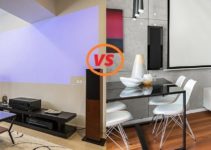- Basic Information 720p Vs 1080p
- What is 720p?
- What is 1080p?
- What is HD?
- 720p Compared To 1080p
- Is There A Big Difference between 720p and 1080p?
Basic Information 720p Vs 1080p
What is 720p?
720p or more precisely 1280 × 720 pixels. This is considered the standard resolution of HD. HDTV signal format has up to 720 horizontal lines with an aspect ratio of 16: 9.
720p resolution refers to 1 MP (1 Megapixel) in security cameras and it stands for 1280 × 720 resolution. For the past few years, the 720p security camera is a good standard resolution camera that line camera HD IP in use.
With the number 720, it represents 720 horizontal lines corresponding to the resolution of the screen. In which the letter “p” represents the continuous scan. 720p can achieve resolution during motion below DVB and ATSC standards.
This standard is shown with a resolution standard that is much higher than that of previous technologies such as SECAM, PAL, or NTSC.
What is 1080p?
1080p resolution gives the corresponding pixel density of 1920 × 1080. The 1080P standard provides a more realistic picture. Experience blur-free, jerky, and lag-free images with lots of high-speed, continuously moving frames.
What is HD?
The term HD was first used in Japan for military purposes, but for some objective reason, it was not applied on television. HDTV is used for commercial programming in the US and is now commonly applied to smart TV lines on the market. Today, HD and Full HD resolutions are mentioned quite a lot on most TVs from mid-range to high-end.
The high resolution helps to reproduce a much more impressive clear, realistic image quality than the low resolution. However, these “perfect” resolution TVs require the power of the source, the playback capability of the receiving device as well as the bandwidth of the system.
This leads to inadequacies when producing mid-range radios aimed at the majority of consumers. For example, a TV that advertises 720p resolution and wants to show 1080p content will have the same output quality as 720p.
Next, the bit-rate is known as the amount of data transferred from the film file to the CPU in 1 second for processing and decoding into images and sound. The higher the bit-rate, the better the movie, the better the sound, but it also means that the CPU processor has to take on more responsibility for processing the data.
720p Compared To 1080p

Obviously, on paper 1080p gives twice as much detail as 720p. However, in reality, this difference is difficult to distinguish with the naked eye on both 720p (HD ready) and 1080p (Full HD) TVs today.
For a 720p TV, 1080p content projection is only as detailed as 720p because that is the limit of the panel resolution. Therefore, the file with 1080p resolution should have twice to three, times the size of a 720p movie to ensure corresponding quality.
That seems as though a great deal, yet what might be said about 1080p? 1080p has 1,920 even pixels for a sum of 2,073,600 pixels which is more than twofold that of 720p.
Does that mean 1080p can deliver an altogether more clear picture than 720p? Perhaps twice as self-evident?
About theory. But, as we will see, it’s not that simple.
The prominent advantage of 1080p can only be recognized with the naked eye when the screen is larger than 60 inches, at that time the 720p movie begins to have the phenomenon of flicker, blur, and worse.
Should I buy a TV with 720p or 1080p resolution? Most of the TVs with 720p resolution today are concentrated and popularly produced on the market because of the reasonable price as well as the resolution reaching “HD standard” when watching television with the naked eye on popular television lines from 24 inches to 32 inches.
The TVs with 1080p resolution will be heavily advertised “Full HD” or “True HD” suitable for the upper class of users, requiring optimal sharpness for each image when enjoying the movies, digital TV programs at home, bring stunning “3D” visual experiences and astonishing clarity.
Choosing to own any television at this time depends on many factors such as image technology, sound, built-in connection utilities, price, model, manufacturer, etc. However, if your need to lean heavily on picture quality for live entertainment with friends and relatives, a television that is not too large in terms of both screen size and 720p “standard” resolution will be a reasonable choice. above all. Through this article, you probably already understand somewhat about screen resolution.
There are times when it comes to investing in 1080p technology and other times 720p is sufficient. Why? Because the human eye is not always able to see what we want.
When it comes to daylight projectors, what you see on the screen is not just the resolution but also the size of the image on the screen and how far you sit from it.
Depending on the usage needs and projection space, for example, if you want to watch a movie, choose 1080p because you will certainly be able to see the difference. It can also help a little when using a project for a bright room.
Is There A Big Difference between 720p and 1080p?
Both 720p and 1080p are considered high resolutions, so you get a nice photo, a sharp video either way. But there are some instances in which the quality can differ.
| 720p | 1080p |
| horizontal: 720 | horizontal: 1080 |
| Progressive scanning | Progressive scanning |
| Price “softer” than | Most expensive price |
Prices for high-definition TVs vary widely. It relies upon numerous variables, including the brand, highlights, and show innovation. The screen type is an equipment factor. Different components adding to the sticker price incorporate screen size, accessibility of brilliant highlights, and screen type (LCD or LED).
By and large, a 720 screen is less expensive than a 1080 one. With a similar 1080 goal, the reformist sweep screen is more costly than the interstitial screen. Be that as it may, contingent upon different components, these examinations may not generally be valid.
As a rule, 720 screens are less expensive than 1080 screens. Inside the 1080 level, reformist sweep shows are more costly than joined. Notwithstanding, contingent upon different elements, these correlations may not generally be the situation.
Blu-Ray, then again, is typically 1080p, so you’ll pass up a great opportunity a piece on the off chance that you have an enormous projector at simply 720p.
Is the goal higher?
Individuals may accept that the higher the goal of the screen is, the more clear the screen show, so they will in general pick a cell phone with a high goal. Is that consistently the case? How about we examine it from alternate points of view.
Potential gain
The image subtleties are more clear. At the correct screen goal, the showcase of the cell phone screen will become more clear. Also, the watching experience will be incredibly improved.
For example, when the picture size is something very similar if the image is at various goals, the lucidity shifts. The higher the goal is, the more clear the subtleties are.
Disadvantage
The higher goal will achieve issues like eye weakness, power utilization, and greater cost.
On the off chance that you utilize a cell phone with a high goal for quite a while, your eyes will effectively be drained even with nearsightedness. Even though it is important to focus on the clearness of the cell phone, it is prudent to put your eyes on the first spot on the list.
In the meantime, the higher the telephone goal is, the more noteworthy the force utilization during the utilization of the cell phone. Also, a higher goal implies higher material expenses, bringing about an increment in the cost of the cell phone.
Another worry is that whether the goal of the screen will influence the nature of photographs. Truth be told, the goal of the cell phone doesn’t address the nature of the camera work.
It is the chip processor, focal point, and center capacity of the camera that decide the nature of photographs. You would do well to pick a telephone with great camera work dependent on the referenced components.
All things considered, it isn’t generally the situation that the higher the goal, the better. With regards to picking a cell phone, don’t put an excess of weight on the screening goal. All things considered, you should choose a goal that suits the size of your telephone.
For instance, for telephones under 5 inches, the goal inclination is 720P. For 5-6 inches ones, 1080P can fundamentally address the issues. For cell phones more than 6 inches, it is prescribed to pick a 2K goal.
Conclusion
With this article, I believe you have the answer to the question: “what is the difference between 720 and 1080?” Thank you for following me!






